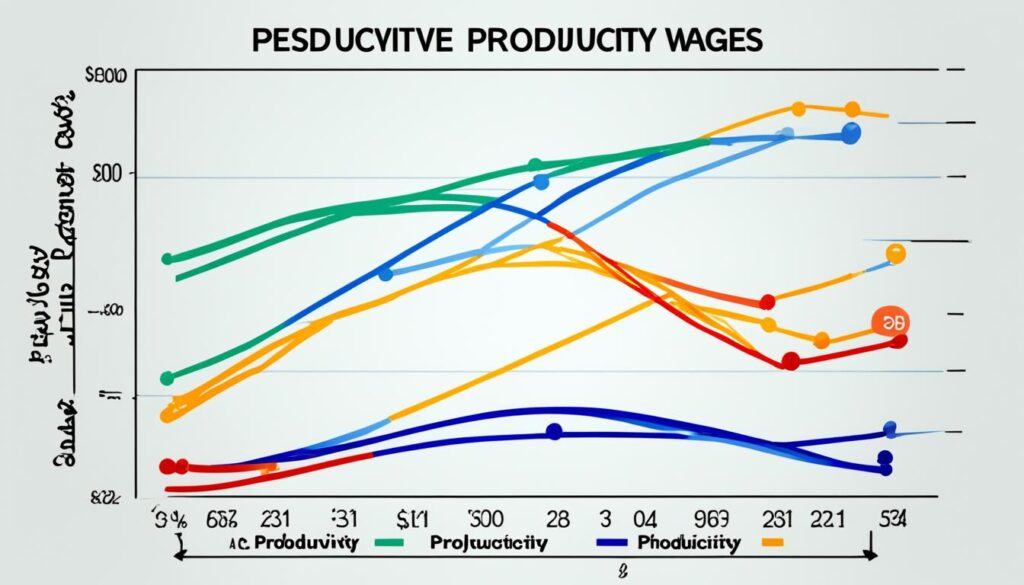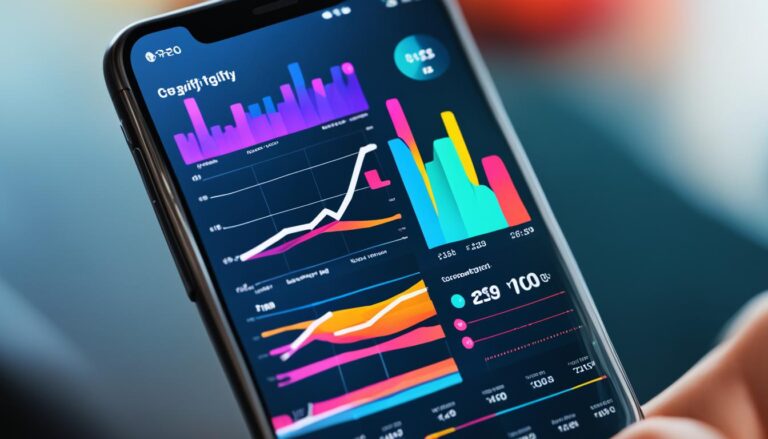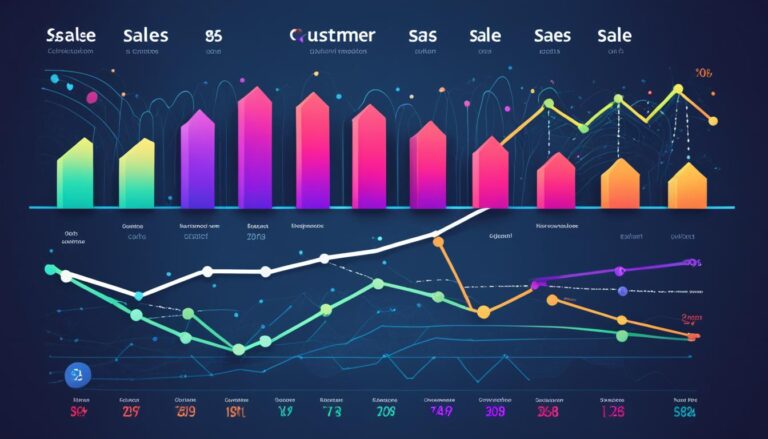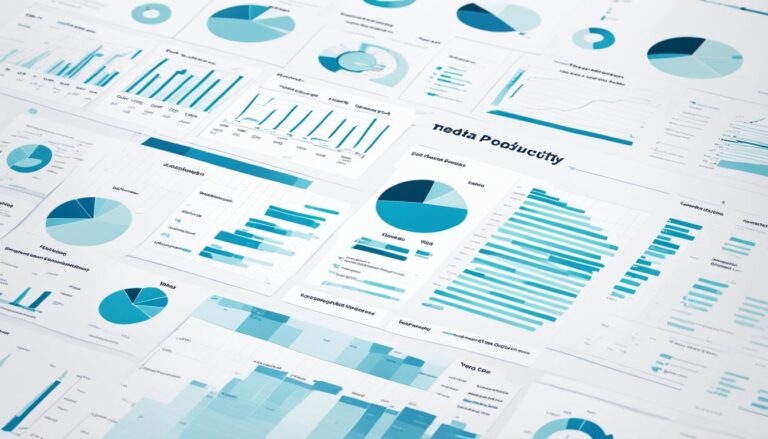Boost Your Growth with Productivity in Economics

Are you looking to enhance your economic growth and improve your standard of living? The key lies in understanding and harnessing the power of productivity in economics. But what exactly is productivity, and how does it impact your financial well-being?
Productivity is more than just a buzzword – it’s a crucial measure of efficiency in the economy. It determines how effectively people and businesses use resources to produce goods and services. By increasing productivity, you can unlock higher wages and pave the way for a better future.
In this article, we’ll explore different forms of productivity in economics, the link between productivity and wages, the role of technology in driving productivity, and the relationship between productivity and consumption. By delving into these topics, you’ll gain valuable insights into how to boost your growth and maximize your potential.
Key Takeaways:
- Productivity is a measure of efficiency in the economy.
- Raising productivity can lead to higher wages and a better standard of living.
- Productivity can be measured at various levels, including workplace, industry, and global productivity.
- Improving technology plays a crucial role in driving productivity growth.
- Capital investment and productivity growth require temporary periods of underconsumption.
Understanding Different Forms of Productivity in Economics
In the field of economics, productivity can be measured and analyzed from various perspectives. Different levels of productivity are examined to gain insight into the efficiency and effectiveness of individuals, industries, and the overall economy. By understanding and evaluating workplace productivity, industry productivity, global productivity, and physical productivity, economists can identify areas for improvement and implement strategies to drive economic growth.
Workplace Productivity
Workplace productivity refers to the overall efficiency of individuals within a workplace environment. It encompasses the performance of employees, managers, and executives in utilizing their skills, knowledge, and resources to produce desired outputs. Enhancing workplace productivity involves optimizing workflows, streamlining processes, and fostering a collaborative and supportive work culture. By increasing workplace productivity, organizations can achieve higher levels of output and profitability.
Industry Productivity
Industry productivity measures the effectiveness of companies within a specific industry in producing goods and services. It focuses on analyzing the methods, technologies, and practices employed by businesses to maximize their output and minimize costs. Improving industry productivity involves adopting advanced technologies, implementing innovative production techniques, and leveraging economies of scale. Benchmarking industry productivity allows companies to identify best practices and implement strategies to gain a competitive advantage.
Global Productivity
Global productivity looks beyond individual workplaces and industries to evaluate the efficiency and effectiveness of all sectors within an economy. It encompasses a broad analysis of various industries, including manufacturing, services, agriculture, and more. By analyzing global productivity, policymakers and economists can identify trends, strengths, and weaknesses in the overall economy. Boosting global productivity requires systemic changes, such as investment in infrastructure, education and training, and fostering an environment conducive to innovation and entrepreneurship.
Physical Productivity
Physical productivity is a measure of the quantity of output produced by one unit of input within a specific unit of time. It examines the efficiency of resource utilization, such as labor, capital, and raw materials, in generating output. Increasing physical productivity involves optimizing production processes, adopting technological advancements, and minimizing waste. By improving physical productivity, businesses can achieve higher levels of output while utilizing fewer resources, leading to increased profitability and sustainability.

| Workplace Productivity | Industry Productivity | Global Productivity | Physical Productivity | |
|---|---|---|---|---|
| Definition | Efficiency of individuals within a workplace | Efficiency of companies within a specific industry | Efficiency of all sectors within an economy | Quantity of output produced by one unit of input |
| Focus | Individual performance, work culture | Industry methods, technologies | Economy-wide analysis | Resource utilization, waste reduction |
| Improvement Methods | Workflow optimization, collaboration | Technology adoption, best practices | Infrastructure investment, innovation | Process optimization, technological advancements |
| Benefits | Higher output, profitability | Competitive advantage | Economic growth | Increased profitability, sustainability |
The Impact of Productivity on Wages
When it comes to economics, productivity has a profound effect on employee wages. As productivity increases, tasks can be completed more efficiently and quickly, leading to potential increases in wages. When businesses invest in technology and replace manual labor with production equipment, they can cut down production time while increasing output, resulting in higher wages for workers.
In a competitive market, labor earns its marginal product, meaning that as productivity increases, workers can earn more for their output. This incentivizes employees to strive for higher levels of productivity, knowing that their efforts will directly impact their take-home pay. Furthermore, increased productivity often leads to improved work quality, which can result in additional financial rewards such as bonuses or promotions.
By understanding the direct link between productivity and wages, both employees and employers can recognize the importance of investing in productivity-enhancing initiatives. Whether it’s adopting new technologies, implementing streamlined processes, or providing ongoing training and development opportunities, these efforts can contribute to higher levels of productivity and ultimately lead to greater financial rewards for workers.
The Effect of Productivity on Wages: A Case Study
To illustrate the impact of productivity on wages, let’s consider the manufacturing industry. A company that invests in advanced machinery and automation can significantly increase its productivity. By automating repetitive tasks and reducing the time required to complete a production cycle, workers can focus their efforts on more complex and value-added activities.
In this hypothetical case study, Company XYZ implemented state-of-the-art machinery in their manufacturing process. As a result, their production time was reduced by 30%, while maintaining the same level of output. This substantial improvement in productivity allowed the company to meet customer demands more efficiently and achieve higher profitability.
| Metrics | Before Implementation | After Implementation |
|---|---|---|
| Production Time | 10 hours | 7 hours |
| Output | 100 units | 100 units |
| Efficiency | 10 units/hour | 14.3 units/hour |
| Wages per hour | $15 | $18 |
| Total Wages | $150 | $126 |
In this case, workers at Company XYZ experienced an increase in wages despite the reduction in production time. The higher efficiency resulting from increased productivity allowed the company to reduce labor costs while maintaining the same level of output. Consequently, Company XYZ was able to allocate the cost savings towards higher wages for their employees.

This case study highlights how productivity improvements can directly impact wages in a positive way. By adopting technologies and implementing strategies to boost productivity, businesses create a win-win situation where both employees and employers benefit.
The Role of Technology in Driving Productivity
Technology plays a crucial role in driving productivity growth. As advancements in technology occur, businesses can improve their efficiency and output. By harnessing the power of technology, companies can streamline processes, automate tasks, and enhance communication. This enables them to accomplish more in less time, thereby increasing productivity.
For example, the introduction of new machines and techniques can significantly boost productivity in industries. Automation replaces repetitive manual tasks, freeing up human resources to focus on more complex and strategic activities. Additionally, technology enables the collection and analysis of vast amounts of data, providing valuable insights for decision-making and process optimization.
The adoption and use of technology can also lead to the reallocation of resources and the growth of other sectors. As industries adopt innovative technologies, they create new opportunities for employment and economic growth. For instance, the rise of e-commerce has revolutionized the retail sector, opening up avenues for online businesses and digital marketing experts.
Over time, technology raises the productive capabilities of individuals and drives economic growth. By leveraging technology, businesses can unlock new possibilities, expand their reach, and improve customer experiences. As a result, productivity increases, leading to enhanced competitiveness and economic prosperity.
Embracing technology is essential for businesses and economies to thrive in the rapidly evolving digital landscape. By investing in technological advancements, societies can unlock new levels of productivity, efficiency, and innovation.

The Impact of Technology on Industries
Technology has transformed various industries, driving significant improvements in productivity. Here are a few examples:
| Industry | Technological Advancement |
|---|---|
| Manufacturing | Automation and robotics |
| Healthcare | Electronic medical records and telemedicine |
| Transportation | GPS tracking systems and autonomous vehicles |
| Finance | Online banking and blockchain technology |
These advancements have revolutionized processes, increased efficiency, and enabled industries to meet the ever-growing demands of the global market.
The Relationship Between Productivity and Consumption
Productivity and consumption are interconnected elements in driving economic growth. To enhance productivity, producers often need to temporarily reduce consumption in order to make investments in new capital projects. This underconsumption period provides funding for businesses to implement productivity-enhancing initiatives, such as upgrading technology, improving infrastructure, and investing in employee training and development.
By focusing on productivity, businesses can increase their output and efficiency, leading to higher future consumption levels. When producers invest in productivity, it sets the stage for economic growth as it allows for the expansion of production capabilities and the creation of more goods and services.
Let’s take a look at a few examples to illustrate the relationship between productivity and consumption:
Example 1: Manufacturing Industry
In the manufacturing industry, investing in productivity can lead to increased production capacity and improved efficiency. By implementing automated production systems, businesses can streamline their operations, reduce costs, and produce goods at a faster rate. This increased productivity allows manufacturers to meet growing consumer demands and ultimately leads to higher consumption levels as more goods become available in the market.
Example 2: Service Industry
In the service industry, productivity plays a crucial role in enhancing customer satisfaction and increasing consumption. By using technology to automate processes and improve service delivery, businesses can serve more customers efficiently. For instance, online booking systems and self-service kiosks in the hospitality sector allow for faster check-ins and a seamless customer experience. The resulting productivity gains enable businesses to attract more customers, leading to increased consumption of their services.

The relationship between productivity and consumption is integral to sustainable development and long-term economic success. By prioritizing productivity growth, businesses can lay the foundation for increased consumption, higher living standards, and economic prosperity.
Conclusion
Productivity measurement is a crucial element in driving economic growth and improving the standard of living. It allows us to assess the efficiency of our resources and identify areas for improvement. Various methods, such as percent changes and indexes, can be used to measure productivity and track its progress over time.
Factors affecting productivity are diverse and multifaceted. Innovation and technology play a significant role in unlocking productivity gains by introducing new processes, tools, and ideas. Changes in inputs, such as raw materials and capital, can also impact productivity. Furthermore, investing in employee skills and creating better work environments can foster a more productive workforce. It is essential for individuals, businesses, and the overall economy to understand and address these factors to achieve sustainable growth.
Total factor productivity (TFP) is a key concept in productivity measurement, representing the residual productivity that cannot be explained by changes in labor and capital inputs alone. TFP captures the efficiency gains resulting from technological advancements, innovation, and improvements in management practices. Enhancing TFP is instrumental in driving economic growth and maintaining a competitive edge in today’s rapidly evolving global market.





